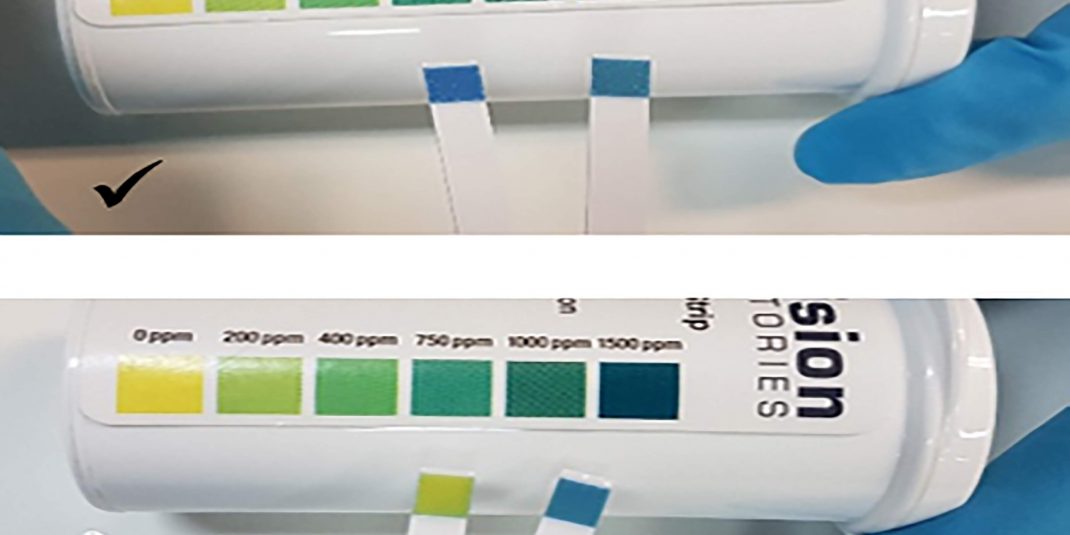Disinfectants
Disinfectants prove to be an integral part of on-farm biosecurity
Using disinfectants as part of your cleaning regime is vital to minimise the spread of Panama disease. Research shows that various disinfectant products are effective in killing fungal spores that cause Panama disease.
Products listed in the table below are examples of disinfectant products which were shown to be effective when applied at 1% solution.


Remember...
Before using any chemicals always check the current registration status and read the product label. A minor use permit is available for banana growers to use these products off-label (PER 86485) http://permits.apvma.gov.au/PER86485.pdf. Label and permit details can be accessed via APVMA website: www.apvma.gov.au
It is important to note that soil reduces the effectiveness of disinfectants. Different soil types have varying impacts on the effectiveness of the products. However, research has shown that once the equivalent of 1g of soil is present in 20mL of solution (1% product) then the effectiveness of products is compromised or reduced.
Investigations into DDAC products (e.g. Steri-maX®, Path-X™, Sporekill® made at 1% solution) has found that when there is no soil contamination, these products remain effective as a disinfectant after being exposed to sunlight, temperature and humidity for up to 12 months.
Quaternary ammonium compound test strips have shown to be an effective tool that measures the concentration of the active ingredient DDAC or BZK in disinfectant products. These easy-to-use test strips do not require dilution of the sample and are used by comparing the colour development on the test strip to the colour scale.
In summary:
- DDAC and BZK disinfectant products used at the correct concentration and as per label or permit specifications (contact times) do kill the fungal spores that cause Panama disease.
- It is important to remove all soil and organic matter before applying any disinfectant product and replace solutions if they become contaminated.
- Easy-to-use test strips can be used to regularly test solutions in footbaths, spray shuttles and wash-down facilities.
More info...
Remember: Always follow and adhere to product label rates and instructions. Label and permit details can be accessed via APVMA website: www.apvma.gov.au
This research was funded as part of project BA14013 Fusarium wilt Tropical Race 4 – Biosecurity and sustainable practices which was funded by Hort Innovation, using the Banana research and development levy, co-investment from the Queensland Department of Agriculture and Fisheries and contributions from the Australian Government. Hort Innovation is the grower-owned not-for-profit research and development corporation for Australian Horticulture.



How can I test my QA disinfecting products?
Test strips can help determine the effectiveness of your disinfecting solution
Disinfectant products that contain the active ingredient didecyl dimethyl ammonium chloride (DDAC – e.g. Sporekill®, Steri-max® and Path-X™) or benzalkonium chloride (BZK – e.g. Bactex, Agriquat) have shown to kill fungal spores that cause Panama disease.
For these products to be effective, it is important they are mixed at a 1% solution. Our researchers have investigated a range of test strips to measure the concentration of the active ingredient of disinfectant products used in footbaths, spray shuttles and drive-through dips.
High level (0 – 1500ppm) or extra high level (0 – 10,000ppm) quaternary ammonium compound test strips are an easy method of testing the active ingredient DDAC or BZK by comparing the colour development on the test strip to a colour scale.
For your information...
1% solution of 120g/L DDAC (e.g. Steri-max®) equates to 1200ppm
1% solution of 100g/L BZK (e.g. Bactex) equates to 1000ppm
1% of solution of 250g/L BZK (e.g. Agriquat) equates to 2500ppm *
*(either dilute and use high level test strips or use extra high level (0 – 10 000ppm) test strips)

For best results, make up a 1% standard solution of the DDAC or BZK disinfectant product you are using. This will allow you to directly compare the exact colour of a 1% solution to the colour of the disinfectant sample you want to test.
Keep this solution in a sealed container for future use.
It is recommended...
It’s recommended that you dip your test strip into the 1% standard solution and the disinfectant sample (e.g. footbath) simultaneously, that way you can compare colour instantly.
1. Dip

Dip test strips into the 1% standard solution and your disinfectant sample and remove immediately.
2. Compare

Immediately compare test strip to colour scale (maximum reading time of 5 seconds).
The colour of your disinfectant sample should be greater than or equal the 1% standard solution (as per image above with green tick).
In summary:
- Use test strips to regularly check the disinfectant solutions in your footbaths, spray shuttles and wash-down facilities to ensure they are at an effective concentration (1% solution).
- Ensure there is less than 5% soil in footbaths and wash-down facilities – that is equivalent to 1g of soil to 20mL of disinfectant solution (1% DDAC or BZK product).
- Be aware that soil with a high clay content may have the potential to influence test strip results.
- Different water sources do not appear to influence the test strip results.
- With no soil present in your disinfecting solution, DDAC products prepared to a 1% solution are still effective at managing spores that cause Panama disease.
For more information about this work or for details on where to purchase the test strips contact the better bananas team –betterbananas@daf.qld.gov.au or 13 25 23
Please note...
There may be factors beyond the scope of the research that has been undertaken using the quaternary ammonium compound test strips which have the potential to influence results.
This trial was funded as part of project BA14013 Fusarium wilt Tropical Race 4 – Biosecurity and sustainable practices which was funded by Hort Innovation, using the Banana research and development levy, co-investment from the Queensland Department of Agriculture and Fisheries and contributions from the Australian Government. Hort Innovation is the grower-owned not-for-profit research and development corporation for Australian Horticulture.


Are cleaning and disinfectant products corrosive?
Are cleaning and disinfectant products corrosive?
Infrastructure such as footbaths and wash-down facilities are important components of effective on-farm biosecurity. Demonstration trials have been conducted to investigate the potential corrosive ability of various cleaning and disinfectant products on different metal surfaces.
Two demonstration trials were conducted and the same treatments were used in both. Products included a detergent made to a 10% solution (Farmcleanse), three products containing 120g/L didecyl dimethyl ammonium chloride (DDAC) made to a 1% solution (Sporekill®, Steri-max® and Path-X™), and water as a control. Both trials demonstrated the effects of the above products on five different metals; unpainted steel, painted steel, galvanised, aluminium and stainless steel (grade 304).
The first experiment consisted of the metals being completely submerged in solution for 8 weeks, whilst in the second experiment the metals were treated by being dipped in the solutions frequently (2-3 times a week) then exposed to field conditions (temperature and humidity) for a total of 12 weeks.


Outcomes of this research
The demonstration trials showed that the detergent and disinfectant products caused low levels of surface rust development over the 8-12 week period for the majority of metals. Unpainted steel was the most susceptible to surface rust development, while galvanised steel, aluminium and stainless steel were the least susceptible.
When submerged in solution, the detergent and disinfectant products did not corrode the metals significantly more than water alone. The water treatment also appeared to have similar corrosive abilities as the other products trialled in this experiment.
When dipped frequently and exposed to field conditions, all three disinfectant products appeared to be more corrosive on unpainted steel compared to the water and detergent treatments. Furthermore, the DDAC products had shown to be more corrosive on unpainted steel when dipped frequently as opposed to the submerged in solution application method.
Remember...
Remember to always follow label directions for cleaning and disinfectant products. After the appropriate exposure time you can rinse metal surfaces with clean water to minimise the risk of rusting.
What did the corrosion demonstration trial show?
Unpainted steel
Submerged in solution
- Water appeared to have similar corrosive abilities as the disinfectant and QA products.
Dipped frequently
- The QA products appeared to be more corrosive than the detergent and water treatments with frequent dipping application.

Painted steel
Submerged in solution
- The paint bubbled and peeled across most treatments, with water only having the least amount of damage to the paint.
- Rust development was present on the cut edges for all treatments.
Dipped frequently
- The paint remained in good condition for all treatments.
- Minor rust development was present where there were chips in the paint.
- Rust development was present on the cut edges for all treatments.
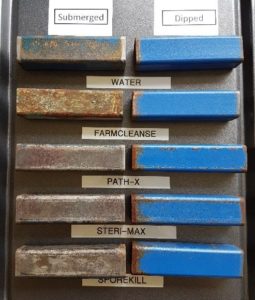
Stainless steel (grade 304)
Submerged in solution
- The stainless steel remained in good condition for the duration of the experiment against all treatments.
- Rust development was present on the cut edges of most treatments with the detergent having the least amount of rust visible.
Dipped frequently
- None of the treatments appeared to degrade the stainless steel for the duration of the experiment.
- Rust was present on the cut edges of the stainless steel on most treatments but with the detergent treatment having the least amount of rust development.

Aluminium
Submerged in solution
- All treatments oxidised the aluminium with the exception of Steri-max®.
- The oxidised aluminium plates changed colour and developed a chalky texture across the surface.
Dipped frequently
- The aluminium remained in good condition for the duration of the experiment across all treatments.

Galvanised steel
Submerged in solution
- A white precipitate developed on the surface of the galvanised steel plates on most treatments, except the detergent.
- Rust developed on the cut edges of the galvanised steel plates treated with water.
Dipped frequently
- The galvanised steel remained in good condition for the duration of the experiment and across all treatments.

For more information about this work contact the better bananas team – betterbananas@daf.qld.gov.au or 13 25 23
This trial was funded as part of project BA14013 Fusarium wilt Tropical Race 4 – Biosecurity and sustainable practices was funded by Hort Innovation, using the Banana research and development levy, co-investment from the Queensland Department of Agriculture and Fisheries and contributions from the Australian Government. Hort Innovation is the grower-owned not-for-profit research and development corporation for Australian Horticulture.


How long are disinfectant products effective for?
How long are disinfectant products effective for?
Quaternary ammonium (QA) products have been shown to kill fungal spores that cause Panama disease. Our researchers have been investigating the longevity of three QA products that contain 120g/L of the active ingredient, didecyl dimethyl ammonium chloride. The QA products evaluated included Sporekill®, Steri-max® and Path-X™, at a 1% (1200ppm) solution.
So what did we do?
The QA products were placed in plastic storage containers outside (with the lids kept on) and exposed to field conditions (e.g. sunlight and temperature) for a period of 12 months. The high level (0-1500ppm) QA test strips were used as indicators to test the solutions on a regular basis, and at 4, 8 and 12 months intervals. At these intervals, small samples of the solutions were collected and inoculated with fungal spores of Panama disease race 1.

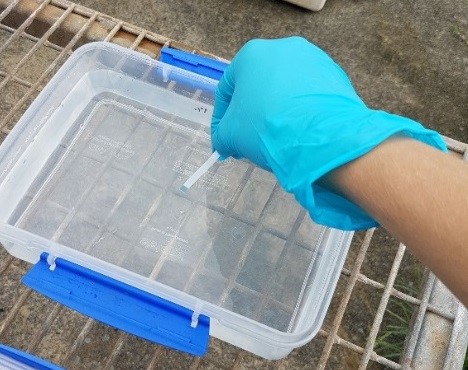
So what was the outcome?
The results showed that after 12 months exposure to sunlight, temperature and humidity, all three QA products were still effective at killing spores that cause Panama disease race 1. Testing at 12 months indicated a reduction in the concentration (using the test strips) for some of the QA products, particularly Path-X™. Despite the potential reduction, no colony growth was detected when samples of the three QA products were inoculated with spores of Panama disease race 1 in the lab. This result indicated that the products were stable, even after 12 months exposure to field conditions.
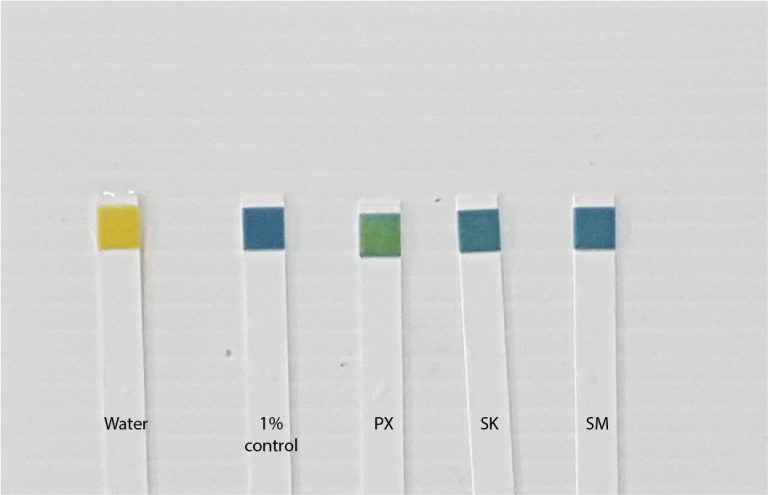

Good news for growers...
QA disinfectants used in infrastructure such as spray shuttles, that isn’t contaminated with soil and organic matter, will be effective for an extended period of time even when exposed to field conditions. However, always remember to schedule regular testing of your disinfectant solutions to ensure they are effective. This can be achieved by using easy-to-use test strips.
For more information about this work contact the better bananas team: betterbananas@daf.qld.gov.au or 13 25 23
This research is part of the Fusarium Wilt Tropical Race 4 – Biosecurity and Sustainable Practices project (BA14013). This project is funded by Hort Innovation, using the banana research and development levy, co-investment from the Queensland Department of Agriculture and Fisheries and contributions from the Australian Government. Hort Innovation is the grower-owned, not-for-profit research and development corporation for Australian horticulture.


Meet a researcher — Jeff Daniells
Jeff Daniells
Jeff has been working with bananas for the past 37 years as a research horticulturist with the Queensland Department of Agriculture and Fisheries based at South Johnstone. He is passionate about bananas and currently works on a number of important industry projects looking at disease resistance and agronomics of alternative varieties — particularly those varieties which have some tolerance to Panama disease tropical race 4.
Growing up in Brisbane Jeff completed his Master’s degree at the University of Queensland and has always had a hands-on approach to learning about bananas. In fact, prior to starting his career, he meticulously kept harvest data (weights, hands and finger numbers) for a stool of Lady Fingers in parent’s backyard. Some call this destiny!
Jeff enjoys Saba (Pisang Gajih Merah) bananas boiled in the jacket served with meat and vegetables and in his spare time enjoys fishing and playing tennis with friends and family.
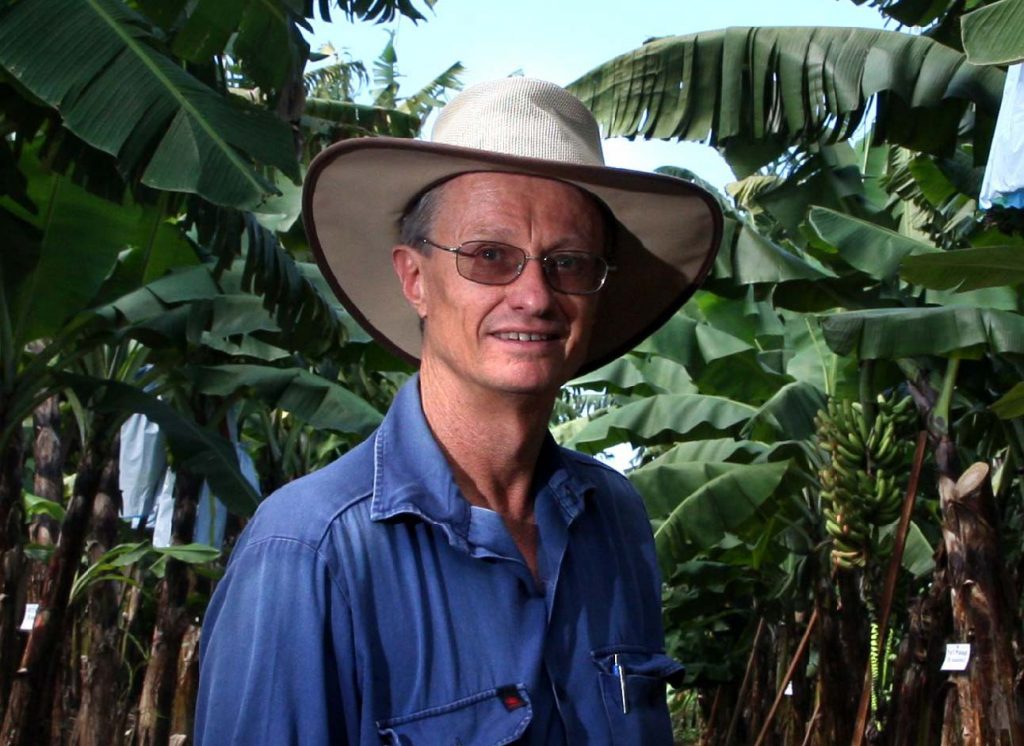
Principal Horticulturist
Department of Agriculture and Fisheries
Centre for Wet Tropics Agriculture, South Johnstone, Qld
Alternative post-harvest product testing
Alternative post-harvest product testing
Research has shown that a range of farm management practices have some incremental influence on disease management of crown end rot (CER), from site selection to irrigation practices through to packaging and dispatch. Specifically, good field and shed hygiene practices help reduce fungal spores making it easier and more effective for post-harvest fungicides to do their work. However, to reduce reliance on fungicide use and address issues associated with chemical resistance, research into potential alternative post-harvest treatments are being investigated.
Twelve post-harvest treatments including disinfectants, biological/organic treatments and alternative fungicides have been screened using clusters of bananas and observing the natural development of CER symptoms.
Crowns of each of the clusters were dipped in various treatments (for 30 seconds or 3 minutes), then ripened under standard ripening conditions. Once the fruit was ripened, the symptom development of CER was rated on a scale of 0-7 (7 being the most severe).


What are the results so far?
This initial screening has indicated that one fungicide (Fungicide B in the table below) appears to be better at managing some of the CER organisms than the currently registered fungicides.
The treatments that showed promise in this initial screening trial require further investigation on larger quantities of fruit and fruit from different production regions. This will help determine if they would be suitable candidates for post-harvest treatment in a commercial setting.
Some of the poorer performing treatments, including a biological product that caused severe fruit burn, will not be further investigated.



The table below provides a summary of the performance rating of each of the post-harvest treatments tested.

If you would like more information on this trial contact the better bananas team at betterbananas@daf.qld.gov.au or 13 25 23.
This work is funded as part of the Cause and management of crown rot of banana project (BA13011). This project is funded by Hort Innovation, using the banana research and development levy, co-investment from the Queensland Department of Agriculture and Fisheries and contributions from the Australian Government. Hort Innovation is the grower-owned, not-for-profit research and development corporation for Australian horticulture.


Developing new resistant varieties Goldfinger mutagenesis trial
Goldfinger overview
Goldfinger (FHIA-01) which was bred by the Honduran Foundation for Agricultural Research (FHIA) is a non-Cavendish dessert banana variety that is highly resistant to Panama disease tropical race 4.
Variety evaluation work previously conducted at South Johnstone has shown the agronomic performance of Goldfinger rates relatively well when compared to Williams. Average bunch weight of plant crop was heavier for Goldfinger at 34.3 kg compared to Williams 30.5 kg. However, the variety had a longer cycling time at 14.4 months from planting to harvest, compared to 12.4 months for Williams. Although it is a reasonably productive variety, improvements are sought in fruit quality characteristics.
Mutagenesis was the technique used to induce change to Goldfinger tissue culture material with the aim of improving fruit quality characteristics, whilst maintaining high resistance to TR4.

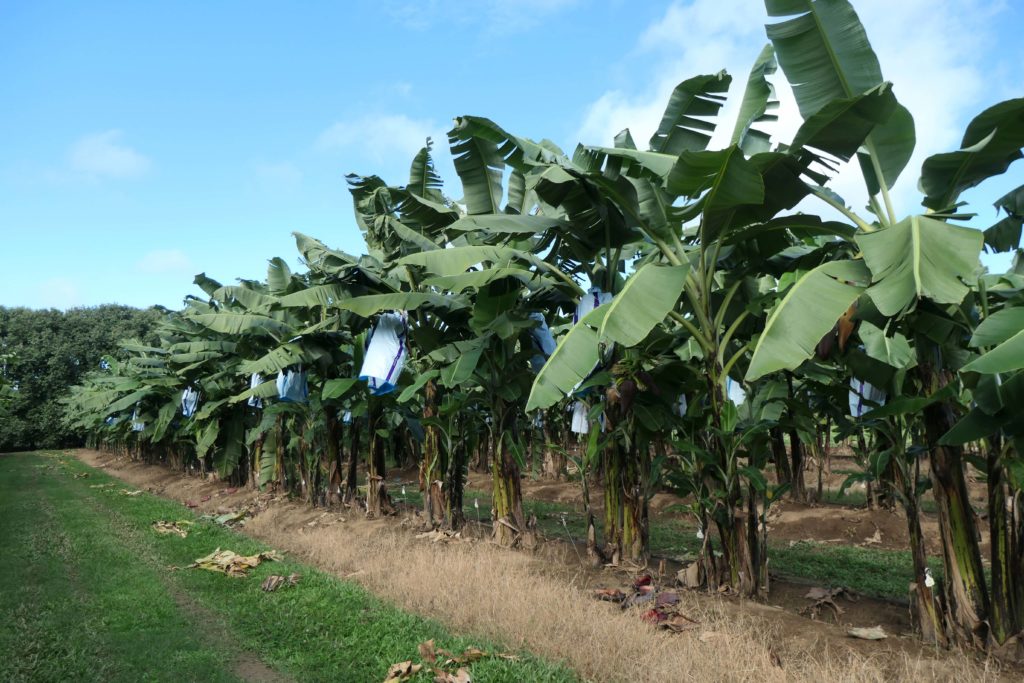
Mutagenesis
Mutagenesis, which is a breeding technique using gamma irradiation to promote changes in tissue cultured plants, has been applied to the cultivar Goldfinger. The aim is to develop an improved variety which retains its tolerance to the disease and has improved fruit quality characteristics.
The first step in this process was to determine how much gamma irradiation to use on this variety. Too much irradiation can severely damage or kill the plant, and too little may not induce sufficient changes to the plants.
Experiments, known as dose response trials, have been conducted at the Maroochy Research Station and the sufficient dosage for Goldfinger was determined.


Screening progress
This project has made selections from the original 630 irradiated Goldfinger plants based on agronomic and post-harvest characteristics. Further taste-testing identified five variants to include in a large-scale consumer and sensory evaluation. Click on the menu below for more information on the screening process.
630 irradiated Goldfinger plants were sent to South Johnstone Research Station, in two batches during June and August 2017 where they were held in the glasshouse prior to planting. Click here for more information.
Following the selection of the top 20 variants from the original 631 plants, sucker and bit material from the original trial was planted in September and October 2019. Click here for more information.
Plants of the top 20 selections were nurse-suckered in December 2020 and the first bunches began emerging in June 2021. Agronomic data has been collected from all variants, but only fruit from the top five performers was sent down for consumer and sensory evaluation at DAF’s Coopers Plains facility in Brisbane. Variants 144, 211, 521, 544 and 903 were the top five tasting selections chosen to be further assessed in the larger consumer surveys. Click here for more information.
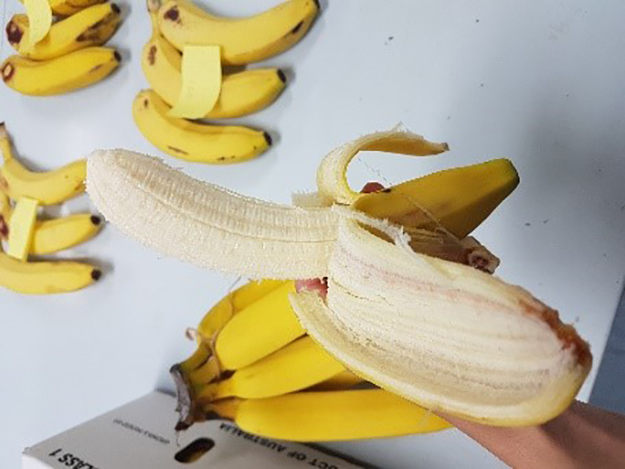
Goldfinger variety research features on ABC's Catalyst program
Check out ABC’s Catalyst story on banana production and the work that’s underway to find a new variety; a variety that can match our love for Cavendish while also having good pest and disease resistance. Paul West speaks with Cameron Mackay and banana researchers Jeff Daniells and Stewart Lindsay to find out more.
More information...
This Goldfinger work was initiated as part of the Fusarium Wilt Tropical Race 4 Research Program (BA14014). At the close of BA14014 funding has been provided through the project Improved Plant Protection for the Banana Industry (BA16001) for continuation of the evaluations. This project has been funded by Hort Innovation, co-investment from the Queensland Department of Agriculture and Fisheries, and contributions from the Australian Government. Hort Innovation is the grower-owned, not-for-profit research and development corporation for Australian horticulture.



Panama disease TR4 variety screening trial
TR4 variety screening trial
Panama disease tropical race 4 (TR4) is a major threat to the Australian banana industry. The availability of different varieties that are resistant to this soil borne disease is key to continuing to produce bananas in the presence of the disease.
Variety screening trials have been established to assess the resistance of different banana varieties to Panama TR4. These trials are an important first step in finding a commercially acceptable alternative to the industry’s main variety ‘Williams’ Cavendish, which is very susceptible to the disease.
The most recent variety screening trial conducted at the Coastal Plains Research Farm in the Northern Territory wrapped up in April 2018. This work was part of the research project, Banana Protection Program (BA10020) and results based on plant crop data are now available. Refer to the trial results below.
The new Improved Plant Protection for the Banana Industry (BA16001) project will continue this work with new trials at the site commencing in December 2018.
About the trial
Conducted at the Coastal Plains Research Farm the trial was established on a site infested with TR4. In summary, the trial included:
⦁ 27 varieties, planted in June 2016
⦁ plants artificially inoculated with Panama TR4
⦁ fortnightly disease ratings recorded
⦁ key agronomic characteristics of plant and first ratoon measured (time to bunching, bunch weight).




Method of trial assessments
All plants were artificially inoculated with colonised millet at planting. Four varieties with known response to Panama TR4 were used as references in the trial. These included:
⦁ FHIA-25 (Highly resistant)
⦁ Goldfinger (Resistant)
⦁ Formosana (Intermediate)
⦁ Williams (Very susceptible)
Assessments for the appearance of internal and external symptoms of the disease were undertaken on a fortnightly basis as well as at plant death or harvest.
These assessments were undertaken on the plant crop as well as most of first ratoon plants. Unfortunately, in January 2018 a storm heavily impacted the trial three months prior to its intended finish. This meant that not all first ratoon information was able to be collected for all of the varieties.

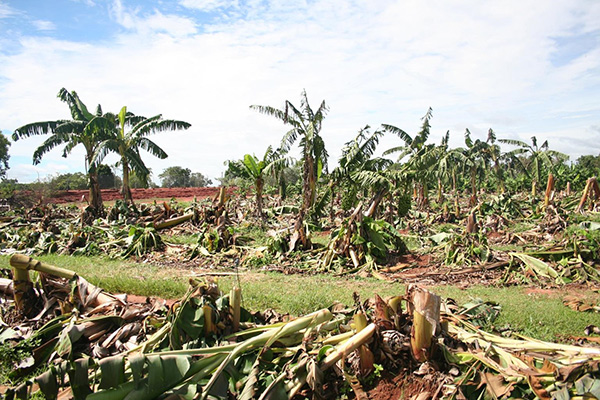
The following categories were used to rank how susceptible or resistant varieties were to Panama TR4 in the plant crop.
Resistant (R): No disease symptoms were observed.
Intermediate (I): Majority of plants harvested with minimal plants showing symptoms or minor symptoms noted. With the appropriate crop management or environment to lower the inoculum levels these should be commercially viable.
Susceptible (S): Majority of plants harvested with most plants showing disease symptoms.
Very susceptible (VS): Plants showing severe symptoms and >50% killed due to TR4 infection.
Trial results
The following results of the plant crop have been reported by the project team as published in Australian Bananas Issue 52.
Disease resistance ranking of plant crop
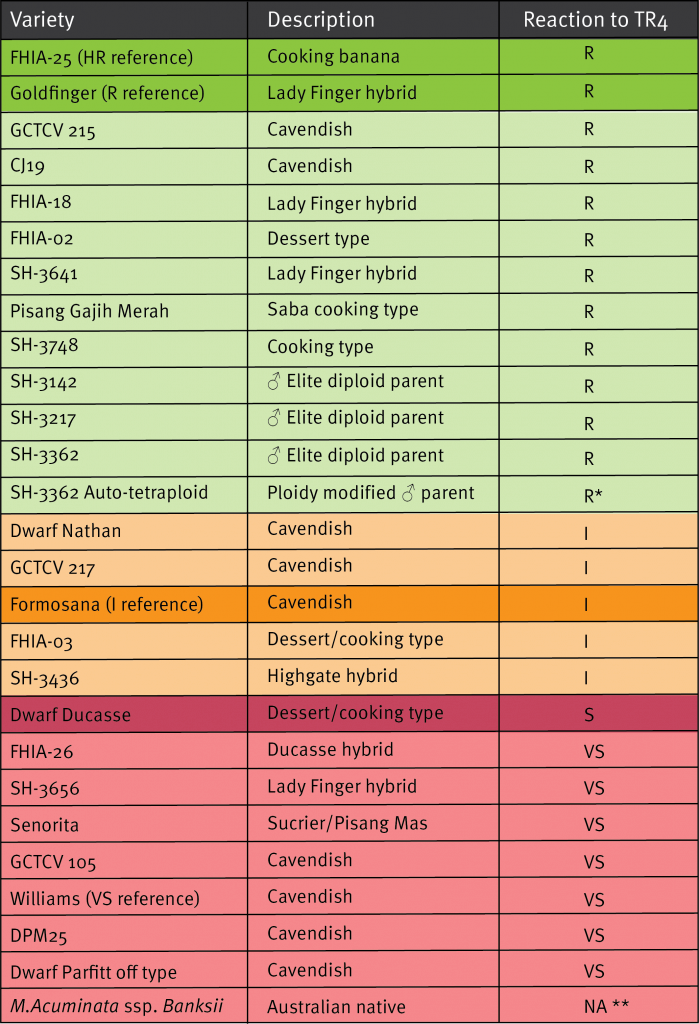
R = Resistant, I = Intermediate, S = Susceptible, VS = Very susceptible
* No disease observed, no signs of bunch at 12 months.
Summary of results for plant crop

Where to from here?
The trial has produced some promising results, with four Cavendish varieties; CJ19, GCTCV 215, GCTCV 217 and Dwarf Nathan showing good resistance to Panama TR4 in the plant crop cycle. These varieties have been flagged as good candidates for mutagenesis. Mutagenesis is a breeding technique that uses gamma irradiation to promote changes in tissue cultured plants. The aim is to develop an improved variety that has commercially acceptable agronomic qualities, while maintaining its good resistance to Panama TR4.
This trial work has already begun with CJ19 and Dwarf Nathan already undergoing mutagenesis.
Future screening trials of new varieties will continue, with a new trial at Coastal Plains Research Farm due to commence in December 2018. This work will be delivered as part of The New Improved Plant Protection for the Banana Industry (BA16001) project.
Did you know...
In September 2017, several Far North Queensland growers visited the Northern Territory and saw the trial first hand.
The video below gives an overview of their visit and some of the grower’s impressions of the trial work being undertaken.
This trial was part of the Banana Plant Protection Program (BA10020). This project was funded by Hort Innovation, using the banana research and development levy, and contributions from the Australian Government, with in-kind contributions from the Queensland Department of Agriculture and Fisheries, the University of Queensland and the Northern Territory Department of Industry, Tourism and Trade. Hort Innovation is the grower-owned, not-for-profit research and development corporation for Australian horticulture.




Host research using Panama disease race 1
Host research using Panama disease race 1
Understanding what species are capable of hosting the fungal organism that causes Panama disease will help inform how weeds and ground covers are managed in areas infested with the disease.
Work in Far North Queensland has used Panama disease race 1 as a surrogate for tropical race 4. Field surveys conducted in the region have identified plant species common to banana plantations that may act as potential alternative hosts. In this context, a host is defined as a plant in which the fungus can survive, often without obvious disease symptoms apparent.
Weed and ground cover species were collected from farms in Far North Queensland with a history of race 1 infection. In total 115 samples from 20 different plant species were analysed for the presence of the fungal organism (Fusarium oxysporum f.sp cubense) that causes Panama disease race 1.
Roots from each of the plant samples were washed to dislodge excess soil before being surface sterilised. Segments of roots were placed in Fusarium selective media, and incubated for 3-5 days to allow fungal growth. The recovered populations were sent to a specialist diagnostic lab in Brisbane for formal identification.
Race 1 was found living within four different species commonly found co-habiting Far North Queensland banana farms. These species were, spiny spider flower (Cleome aculeata), Youngia japonica, crowsfoot grass (Eleusine indica) and summer grass (Digitaria ciliaris).




Please note...
Panama disease race 1 (R1) was used as a surrogate for Panama disease tropical race 4 (TR4), as access to TR4 infested banana properties in Queensland is restricted.
This trial was funded as part the Fusarium Wilt Tropical Race 4 – Biosecurity and Sustainable Practices project (BA14013). This project was funded by Hort Innovation, using the banana research and development levy, co-investment from the Queensland Department of Agriculture and Fisheries and contributions from the Australian Government. Hort Innovation is the grower-owned, not-for-profit research and development corporation for Australian horticulture.


- « Previous Page
- 1
- …
- 10
- 11
- 12
- 13
- 14
- …
- 17
- Next Page »






